From Concrete Lot to Gracious Organic Garden in Seattle
“It’s about balance,” says painter and horticulturist Amy Ockerlander about the organic gardens surrounding her colorful and eye-catching Seattle home. Tapping into her more than 20 years of experience in horticulture, Ockerlander transformed a concrete parking lot into a lush oasis that envelops her house and reflects her deep appreciation of plant life.
“Often people think organic gardening just means not using chemicals, but true organic gardening means supporting life — all life,” says Ockerlander, who shares the home with husband Alan Brookfield, a clinical engineer. “Everything in a garden has a purpose. The plants are useful: They’re edible, fragrant or herbal; they attract pollinators and birds. The garden ‘pests’ are food for the animals. Many weeds are excellent for the soil — it’s about knowing why something’s in the garden.”
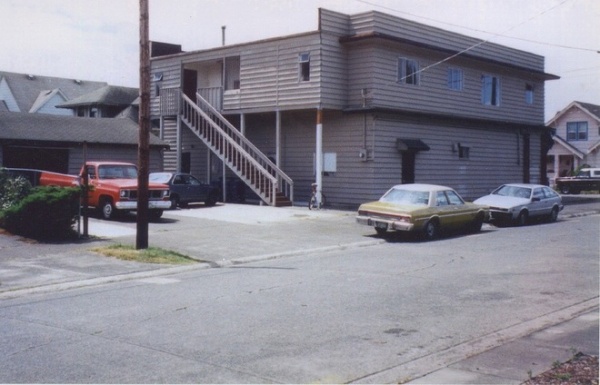
Garden at a Glance
Who lives here: Amy Ockerlander, Alan Brookfield, their 4 dogs and a cat
Location: Ballard neighborhood of Seattle
Years created: Different parts were created in 2001, 2002 and 2005.
“When we bought the building, the entire backyard was a concrete parking lot. The only thing green was a narrow grass strip on the south side,” Ockerlander recalls. “Everything that’s here now was planted in 2001 or later.”
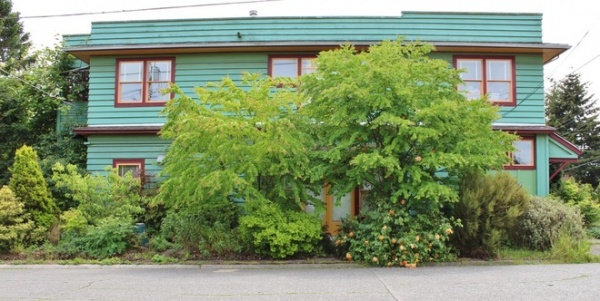
AFTER: The front entrance is located on the north side of the home, which in spring and summer is nearly hidden behind abundant plant life. English shrub roses wind their way up and into the leaves of a katsura tree.
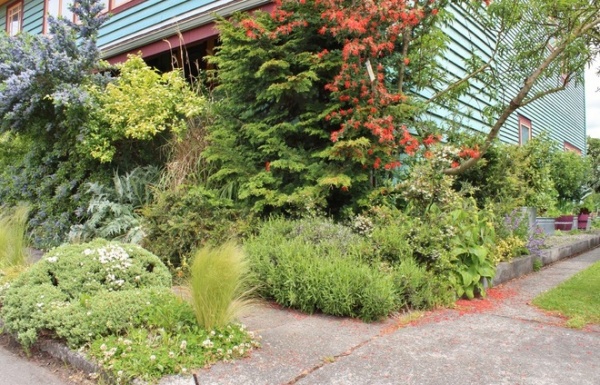
The home is located on a very busy street with many passersby, so some protection from the sidewalk was needed. The couple’s solution was to plant a tapestry hedge along the west side of the home, to act as a natural fence. A vibrant Chilean firetree anchors the corner of this drought-tolerant hedge.
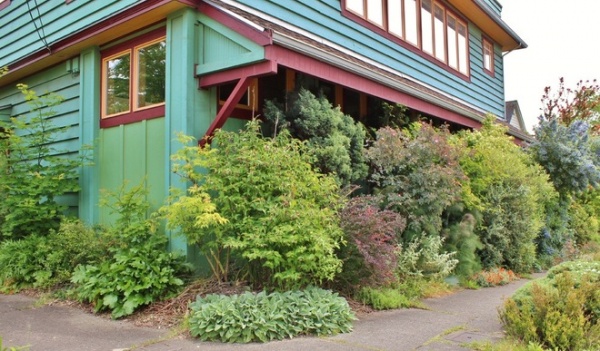
Although planted as burglar deterrents, the home’s west-side plants have other uses as well: Rosa glauca, a self-sowing rose, offers rose hips; bronze fennel and Himalayan honeysuckle attract bees; and variegated El Dorado wild lilac fixes nitrogen in the soil.
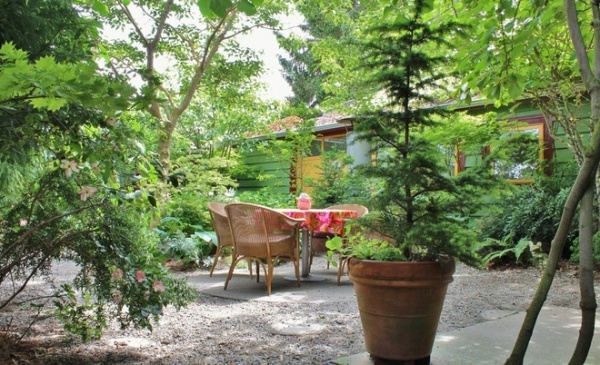
Anchored on the north and east by a fence, on the west by the house and on the south by a garden-shed shop (a former garage), the backyard garden is now a lush, private oasis.
A dining area sits on a central circular concrete pad, which Ockerlander surrounded with crushed gravel. The inset stepping stones appear random, “but are actually a way for me to walk from one end of the garden to the other barefoot,” she says.
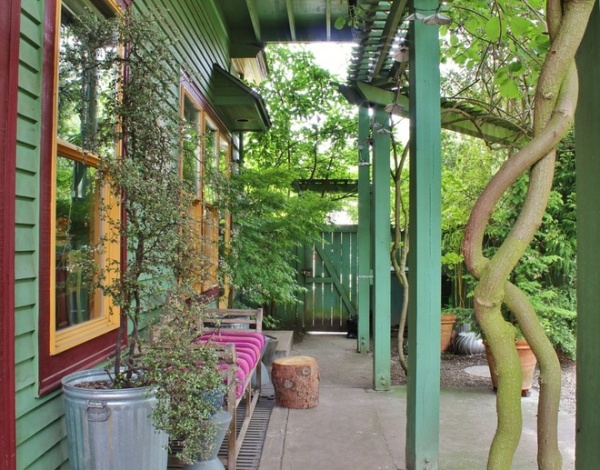
Columns supporting a second-story balcony help create a feeling of grandeur. Galvanized steel, a material also used throughout the interior, reappears in the garden in the form of trash cans used as planters.
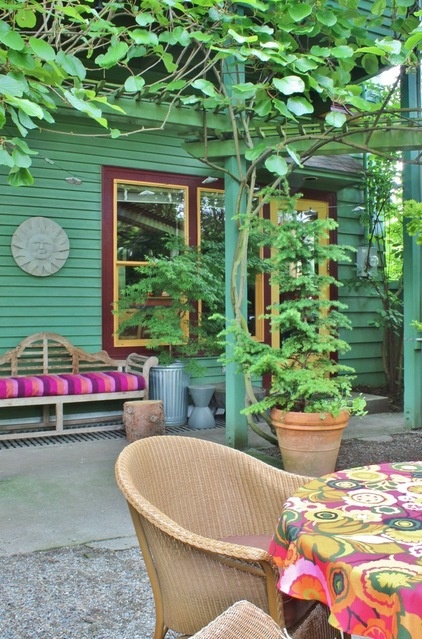
Evergreen, arctic and hardy kiwi vines climb vibrantly up the balcony columns and across a diagonal arbor, creating a dense canopy overhead. “When you walk into the backyard from the sidewalk, it’s very much like walking into the interior of a forest,” says Ockerlander. “That’s what I tried to create here. This area is modeled after a forest garden, which has its roots in permaculture: including as many plants as possible into a landscape that have a use.”
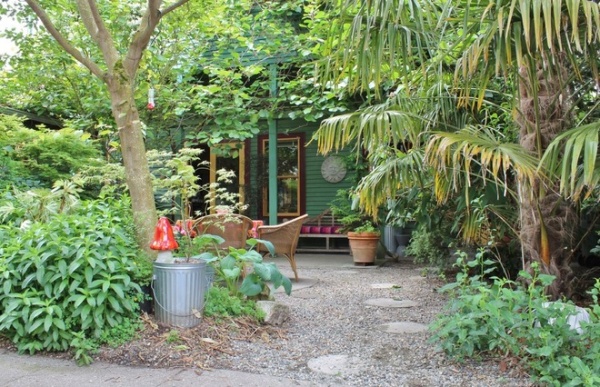
“I do like things to be pretty, but you won’t find any beauty bark here,” says Ockerlander. “My gardening philosophy is ‘chop and drop’: everything that’s put into the garden comes from the garden. All that organic debris that is called yard waste is what your plants are pulling from the soil. So if you cart it away, at some point your soil is depleted.”
She turns yard waste into compost and also chops up the woody parts and puts that back down as mulch. “It’s like in the forest,” she says. “Things drop on the ground all the time, and it works.”
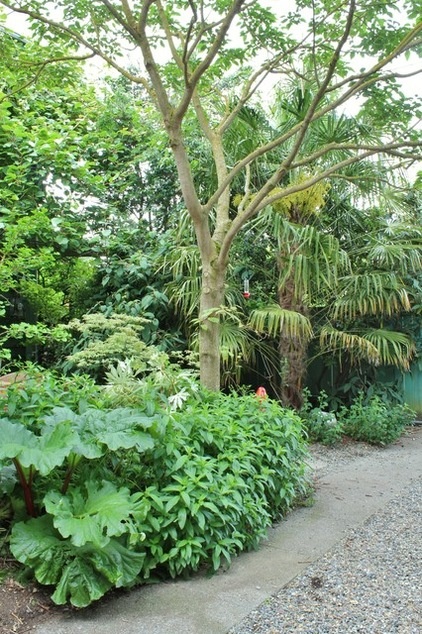
A harlequin glorybower tree takes center stage in the garden. “I knew I wanted a tree in the middle of the garden, and I wanted it to grow fast,” Ockerlander explains. It’s also scaled for the yard, as it will reach a mature height of 30 feet and sports a rounded shape. The tree is intensely fragrant in late June, has tubular white flowers beloved by hummingbirds and produces masses of metallic-blue berries. “Cedar waxwings eat the berries,” she says. “They seek the tree out. Clearly they see it as a good food source.”
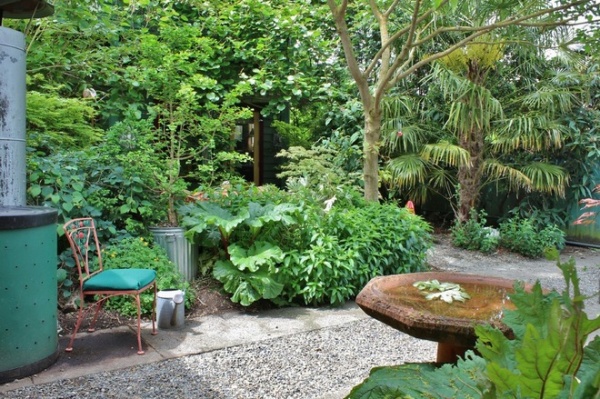
A drum compost bin sits close to an outdoor heater and a chair where the homeowners enjoy the garden view and watch who visits the birdbath. A steel trash can holds a tree, adding height as well as the ability to move it around to other parts of the yard.
“Filling empty areas in your garden with pots is such an easy thing to do,” says Ockerlander. “And when you water your pot, you’re watering the plants all around that pot, too.”
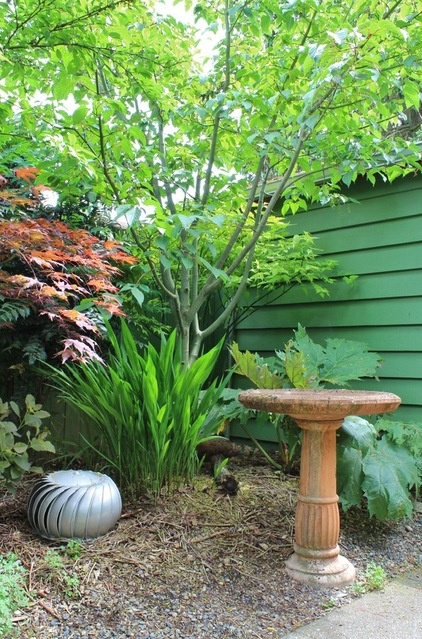
“Having plants which attract insects then attract birds,” says Ockerlander. “They all have a place in the garden.”
She is a big believer in letting things fall where they may. “Plants from gardens on other sides of the house pop up in the backyard. Birds eat the berries on those plants, then fly back here, and the seeds ultimately make their way down into the soil. If I see a plant growing where I didn’t plant it, and the plant is useful, I leave it.”
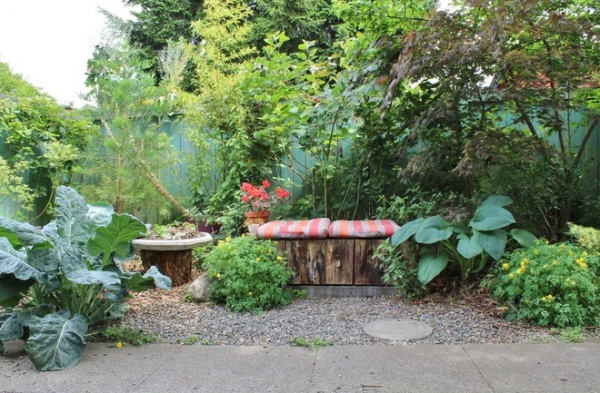
The northeast corner of the garden is a prime spot in which to sit down and rest awhile. The bench is a slab of butcher block salvaged by the couple’s contractor, who works for Lunde Construction. Pots of sweet shoot bamboo sit next to tree kale grown from seeds from Seattle Tilth. “It is absolutely delicious,” Ockerlander says.
Triple crown thornless blackberry is cultivated for its huge berries and bee-friendly nature, while Dublin Bay roses add a splash of red to this green composition. “There’s also a baby giant sequoia,” the owner says. “I planted it now, so that in 40 years, if our neighbors no longer have their giant evergreen tree, there will still be a large tree in this corner.”
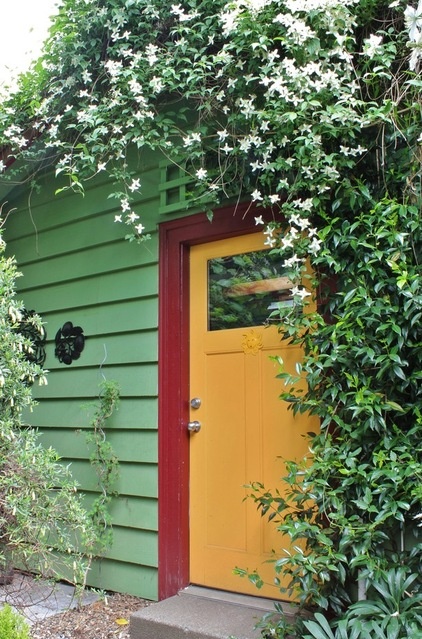
The shop and garden shed was originally the garage. Now its roof is home to a mass of clematis intermingled with star jasmine.
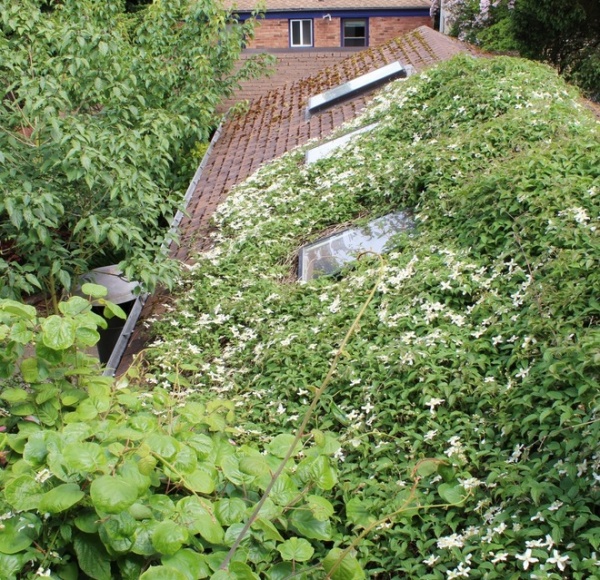
Kept from obscuring the shed’s skylights, the clematis is otherwise left to tumble and curl and grow across the roof and sides of the shed. “My clematis simply makes me happy,” Ockerlander says.
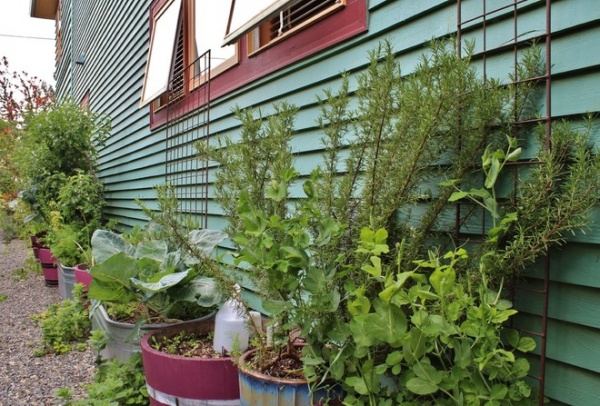
On the south side of the home is a narrow strip sandwiched between the house and the neighbor’s driveway. “This was the first garden we made,” Ockerlander says. “It used to be a strip of grass. But by the time the house remodeling was done, there wasn’t much grass left.”
Making the most of the situation, she turned the swath of soil into a container vegetable garden. “But containers are expensive, so I used an inexpensive steel horse trough as a planter,” she says. The troughs are combined with painted salvaged wine barrels so she can grow a wide variety of vegetables and herbs. Much-maligned mint is grown in the gravel bed. “It grows just fine, but it keeps it under control,” Ockerlander says.
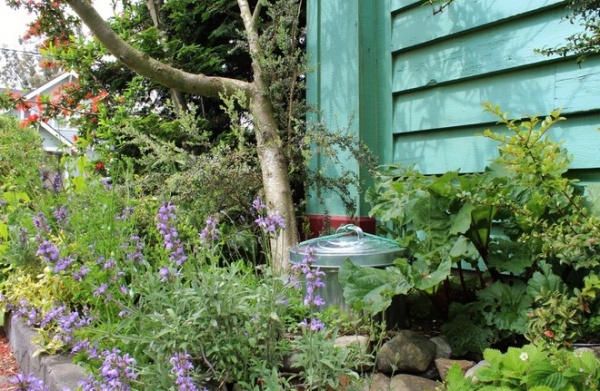
At the west end of the garden is another steel trash can, but this one is half buried in the dirt. “There are so many ways to compost that are truly brainless; they’re so easy,” says Ockerlander. “This is just a small bin with holes drilled on the bottom and sides. I throw kitchen scraps and yard waste in here, put the top on, and use a bungee cord to keep the raccoons out. Worms come in through the holes, and soon I have this great rich compost full of worm casings. Then I just spread it back in the garden.”
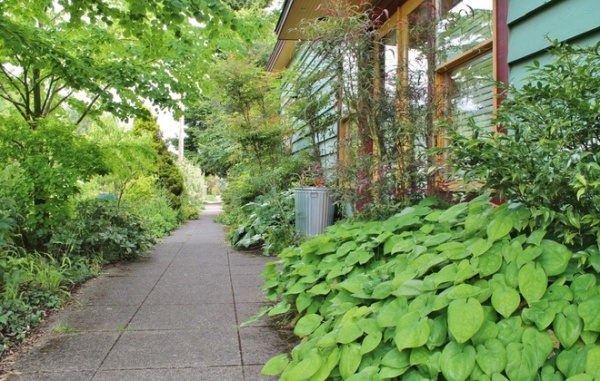
A multitude of plants with medicinal and culinary uses lines both sides of the sidewalk, from huckleberry and witch hazel to plantain, lady’s mantle, black elderberry and bleeding heart. Sweet cicely, with intense, licorice-flavored seedpods, acts as a dynamic accumulator: a plant with a deep taproot that loosens the soil and adds nutrients, feeding the plants around it.
“Weeds can be dynamic accumulators, too,” Ockerlander says. “Like dandelions. I always leave dandelions in the garden. If you’re composting and chopping and dropping, you’ll have that layer around your plants and the dandelion seeds won’t be such a problem. Dandelions are wonderful. They help the soil, they’re edible, and you can roast their roots. Leave the dandelions!”
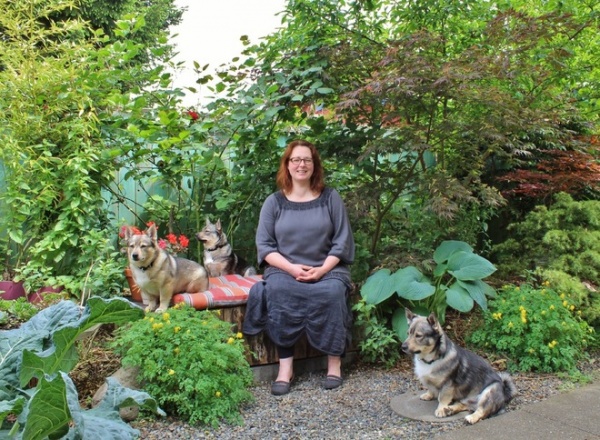
“Nature provides everything it needs to grow itself. Sometimes we just need to let a plant grow big enough to see what it is before we decide it’s a weed and pull it,” says Ockerlander, seen here. “And if it is a weed, it can be very good for your garden to leave it, too.”
See more photos of this garden
Browse more beautiful gardens












